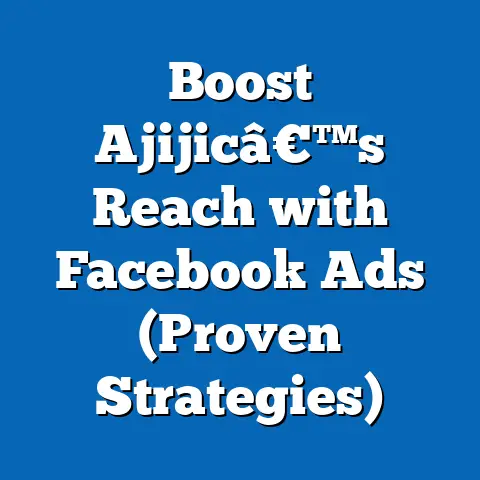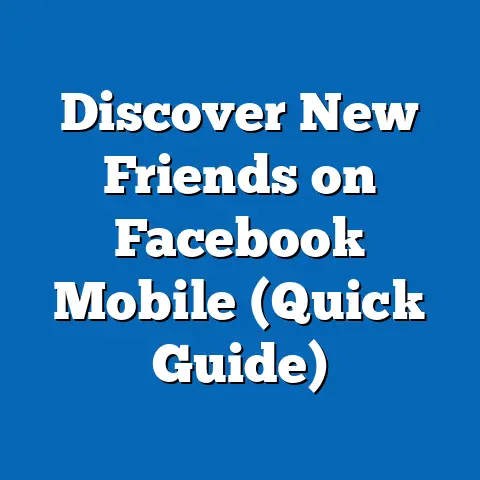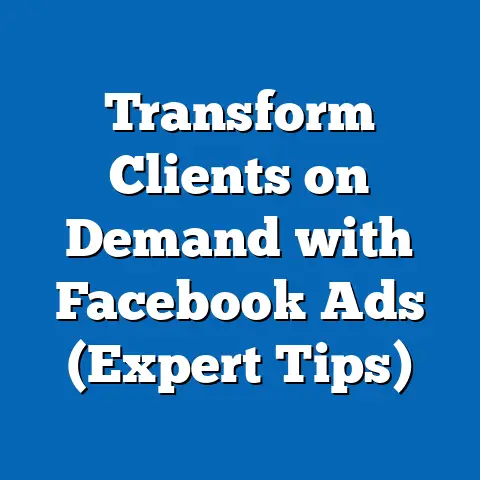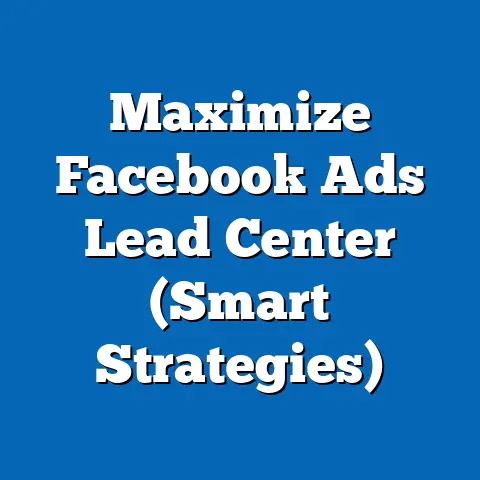Master Facebook Ad Targets (Breakthrough Strategies Revealed)
In the ever-evolving landscape of digital marketing, mastering Facebook ad targeting has become a cornerstone for businesses seeking to maximize their reach and engagement. With over 2.9 billion monthly active users as of 2023, according to Statista, Facebook remains a dominant platform for advertisers across industries. However, the sheer scale of its user base demands precision targeting to ensure campaigns resonate with the right audience.
This article delves into expert-picked strategies for mastering Facebook ad targeting, exploring breakthrough approaches that have redefined how marketers connect with consumers. We will begin by discussing key defining characteristics of effective targeting, the historical evolution of Facebook’s advertising tools, and the broader societal implications of hyper-targeted ads. Subsequent sections will analyze specific strategies, backed by data and real-world examples, while addressing the implications for businesses, consumers, and digital culture at large.
Expert Picks: Defining Characteristics, Historical Context, and Societal Implications
Key Defining Characteristics of Effective Facebook Ad Targeting
Effective Facebook ad targeting hinges on a deep understanding of audience segmentation, behavioral data, and platform-specific tools. Experts emphasize the importance of leveraging Facebook’s vast data ecosystem, which includes demographic details, interests, behaviors, and even life events. According to digital marketing strategist Amy Porterfield, the ability to create hyper-specific Custom Audiences—such as targeting users who have visited a website or engaged with a specific post—sets successful campaigns apart.
Another defining characteristic is the use of Lookalike Audiences, which allow advertisers to reach users similar to their existing customers. This feature, powered by machine learning, analyzes patterns in user data to identify potential high-value prospects. Additionally, experts like Neil Patel highlight the growing role of dynamic ads, which automatically tailor content to individual users based on their browsing history or preferences, enhancing relevance and conversion rates.
The integration of psychographic data—insights into values, attitudes, and lifestyles—further refines targeting precision. Unlike traditional demographic targeting, psychographics enable brands to connect on an emotional level, crafting messages that resonate with specific mindsets. These characteristics collectively underscore a shift toward personalization, a trend that continues to dominate digital advertising.
Historical Context of Facebook Advertising
Facebook’s advertising journey began in 2007 with the launch of Facebook Ads, initially offering basic targeting options based on age, gender, and location. This was a time when social media marketing was still in its infancy, and businesses were experimenting with the concept of online community engagement. The platform’s early ads were rudimentary, often resembling sidebar banners with limited interactivity.
The mid-2010s saw further advancements with the rollout of Lookalike Audiences and the Pixel tracking tool, which enabled advertisers to monitor user behavior across websites and apps. These innovations coincided with growing concerns over data privacy, culminating in the 2018 Cambridge Analytica scandal, which exposed how user data was misused for political advertising. In response, Facebook tightened its data policies and introduced transparency tools, such as the “Why am I seeing this ad?” feature, to rebuild user trust.
More recently, the 2021 iOS 14.5 update by Apple, which restricted tracking via the App Tracking Transparency framework, posed new challenges for Facebook advertisers. This shift forced marketers to adapt, focusing on first-party data and contextual targeting over third-party cookies. Understanding this historical trajectory is crucial for appreciating the current state of Facebook ad targeting and anticipating future developments.
Societal Implications of Hyper-Targeted Advertising
The rise of hyper-targeted Facebook ads has profound implications for society, influencing consumer behavior, privacy norms, and even cultural dynamics. On one hand, personalized ads enhance user experience by delivering relevant content, reducing the clutter of irrelevant promotions. A 2022 study by eMarketer found that 74% of consumers feel frustrated when content is irrelevant, underscoring the value of precise targeting.
However, this precision comes at a cost. The extensive collection of user data raises significant privacy concerns, as individuals often remain unaware of how their information is used. The Cambridge Analytica scandal highlighted the potential for misuse, sparking debates over ethical advertising practices and the need for stricter regulations. In the European Union, the General Data Protection Regulation (GDPR) of 2018 set a precedent for data protection, influencing global standards and forcing platforms like Facebook to adapt.
Beyond privacy, hyper-targeting can contribute to echo chambers, where users are repeatedly exposed to content that reinforces their existing beliefs. This phenomenon, often amplified by algorithmic biases, has been linked to polarization in political and social discourse. A 2020 study by the Pew Research Center found that 64% of Americans believe social media platforms contribute to divisive content, partly due to targeted advertising.
Moreover, there are economic implications for businesses of all sizes. While large corporations with substantial budgets can leverage advanced targeting tools, small businesses may struggle to compete, widening the digital divide. These societal impacts necessitate a balanced approach to targeting, where innovation is paired with ethical considerations.
Breakthrough Strategies for Mastering Facebook Ad Targeting
1. Leveraging First-Party Data in a Post-Cookie World
With third-party cookie tracking on the decline—due to privacy regulations and browser updates—first-party data has emerged as a cornerstone of effective targeting. First-party data, collected directly from customer interactions on a brand’s website, app, or CRM system, offers a reliable alternative for personalization. Experts recommend building robust data collection mechanisms, such as email sign-ups, loyalty programs, and on-site surveys, to gather actionable insights.
For instance, a 2023 case study by HubSpot revealed that businesses using first-party data for Custom Audiences on Facebook saw a 30% increase in ad ROI compared to reliance on third-party data. Tools like the Facebook Conversions API further enable brands to track user actions without cookies, ensuring data accuracy. This shift not only aligns with privacy trends but also fosters trust by prioritizing transparency in data usage.
However, the transition requires investment in data infrastructure and customer relationship management. Small businesses, in particular, may face challenges in scaling these efforts. Despite the hurdles, mastering first-party data is a forward-thinking strategy in an era of tightening privacy controls.
2. Optimizing Lookalike Audiences with Micro-Segmentation
Lookalike Audiences remain a powerful tool for expanding reach, but experts advocate for micro-segmentation to enhance precision. Rather than creating broad Lookalike Audiences based on an entire customer base, marketers can segment their source audience by specific behaviors—such as high spenders, frequent buyers, or recent engagers—and build tailored Lookalikes for each group. This approach ensures that the new audience closely mirrors the most valuable segments of existing customers.
A 2022 report by Social Media Today found that campaigns using micro-segmented Lookalike Audiences achieved a 25% higher click-through rate compared to generic Lookalikes. Additionally, layering demographic or interest-based filters on top of Lookalikes can further refine targeting. For example, a fitness brand might target a Lookalike Audience of high-frequency buyers while narrowing it to users interested in yoga or CrossFit.
The challenge lies in maintaining a balance between granularity and audience size, as overly narrow segments may limit reach. Testing and iteration are key to finding the sweet spot. This strategy exemplifies how data-driven creativity can unlock new growth opportunities on Facebook.
3. Harnessing the Power of Video Ads and Dynamic Content
Video content continues to dominate user engagement on Facebook, with the platform reporting that video ads generate 12 times more shares than text or image-based ads. Experts like Mari Smith recommend pairing video ads with dynamic creative optimization (DCO), which automatically customizes ad elements—such as headlines, images, and calls-to-action—based on user preferences. This combination maximizes relevance and drives higher conversion rates.
For instance, a clothing retailer might use DCO to showcase different products to users based on their past browsing history, ensuring the ad feels personalized. A 2023 study by Advertiser Perceptions found that dynamic video ads on Facebook increased purchase intent by 40% compared to static ads. Furthermore, short-form videos—under 15 seconds—tend to perform best, aligning with shrinking attention spans in the digital age.
Implementing this strategy requires investment in creative assets and a deep understanding of audience behavior. However, the payoff in engagement and ROI makes it a worthwhile endeavor for brands seeking to stand out in a crowded feed.
4. Exploring Advanced Behavioral and Psychographic Targeting
While demographic targeting remains foundational, advanced behavioral and psychographic targeting offers a deeper level of connection. Behavioral targeting focuses on user actions, such as past purchases, app usage, or event attendance, to predict future intent. Psychographic targeting, on the other hand, taps into values, interests, and personality traits, enabling brands to craft emotionally resonant messages.
For example, a travel company might target users who have searched for flights (behavioral) and are interested in sustainable tourism (psychographic), creating a campaign that highlights eco-friendly destinations. According to a 2022 Nielsen report, ads incorporating psychographic insights saw a 35% uplift in brand favorability. Facebook’s detailed interest categories and life event triggers—such as engagements or new parenthood—facilitate this nuanced approach.
The ethical implications of such targeting cannot be ignored, as overly intrusive ads may alienate users. Transparency and value-driven messaging are essential to maintaining trust. When executed thoughtfully, this strategy transforms ads from interruptions into meaningful interactions.
5. Adapting to Algorithmic Changes and Testing Frameworks
Facebook’s ad delivery algorithm is constantly evolving, influenced by user feedback, platform goals, and external pressures like privacy regulations. Experts stress the importance of continuous testing to adapt to these changes, using A/B testing frameworks to compare ad variations across audiences, placements, and formats. Multivariate testing, which analyzes multiple variables simultaneously, can uncover deeper insights into performance drivers.
A 2023 study by WordStream revealed that advertisers who tested at least three ad variations per campaign achieved a 20% lower cost-per-click on average. Additionally, tools like Facebook’s Automated Rules allow marketers to set parameters for pausing underperforming ads or scaling successful ones, optimizing budgets in real time. Staying agile in response to algorithmic shifts—such as the reduced emphasis on engagement metrics post-iOS 14.5—ensures campaigns remain effective.
Testing requires patience and a willingness to iterate, as results may vary across industries and audience segments. Nevertheless, a data-driven testing culture is indispensable for long-term success on the platform.
Implications for Businesses, Consumers, and Digital Culture
Impact on Businesses
Mastering Facebook ad targeting offers businesses unparalleled opportunities to connect with customers, drive sales, and build brand loyalty. Small and medium-sized enterprises (SMEs), in particular, benefit from the platform’s relatively low entry barriers, allowing them to compete with larger players through creative targeting. However, the increasing complexity of tools and privacy restrictions demands ongoing education and adaptation, posing challenges for resource-constrained businesses.
Moreover, the shift toward first-party data and personalized content requires investment in technology and talent. Companies that fail to prioritize these areas risk falling behind in a competitive landscape. Conversely, those that embrace innovation—such as dynamic ads or micro-segmentation—can unlock significant growth, as evidenced by the success stories of brands like Warby Parker and Casper, which scaled through precise targeting.
Impact on Consumers
For consumers, hyper-targeted ads present a double-edged sword. On one hand, relevant ads enhance the online experience, introducing products or services aligned with individual needs. On the other hand, the pervasive nature of data collection fuels privacy concerns, with many users feeling uneasy about being “watched” online.
Consumer empowerment tools, such as ad preference controls and transparency features, offer some relief, but their effectiveness depends on user awareness and platform accountability. As digital literacy grows, consumers are likely to demand greater control over their data, shaping the future of advertising practices. Brands must balance personalization with respect for boundaries to maintain trust.
Impact on Digital Culture
At a cultural level, Facebook ad targeting influences how information is disseminated and consumed. The ability to tailor messages to niche audiences has democratized marketing, enabling diverse voices—from independent creators to advocacy groups—to reach their communities. However, the risk of echo chambers and algorithmic bias remains a pressing concern, as targeted ads can reinforce existing divides.
The cultural narrative around privacy and technology is also evolving, with public discourse increasingly focused on ethical data use. High-profile incidents, like the Cambridge Analytica scandal, have heightened scrutiny of platforms like Facebook, prompting calls for regulation. As digital culture continues to grapple with these tensions, advertisers must navigate a landscape where societal values and business goals intersect.
Conclusion: Forward-Looking Insights and Uncertainties
Mastering Facebook ad targeting is both an art and a science, requiring a blend of creativity, data analysis, and ethical consideration. The strategies outlined—leveraging first-party data, optimizing Lookalike Audiences, embracing video and dynamic content, exploring behavioral targeting, and adapting to algorithmic changes—represent the cutting edge of digital advertising. Backed by expert insights and empirical data, these approaches offer a roadmap for success in a competitive and ever-shifting landscape.
Looking ahead, the future of Facebook ad targeting will likely be shaped by advancements in artificial intelligence, further privacy regulations, and evolving user expectations. The rise of augmented reality (AR) and immersive ad formats could redefine engagement, while stricter data laws may push brands toward contextual targeting over personal data reliance. However, uncertainties remain, particularly around global regulatory harmonization and the long-term impact of privacy-first policies on ad effectiveness.
As marketers navigate these changes, a commitment to transparency, experimentation, and consumer-centricity will be paramount. While the path forward is not without challenges, the potential to connect meaningfully with audiences on a platform as vast as Facebook remains a powerful motivator. By staying attuned to trends and prioritizing ethical practices, businesses can turn targeting challenges into opportunities for innovation and growth.






